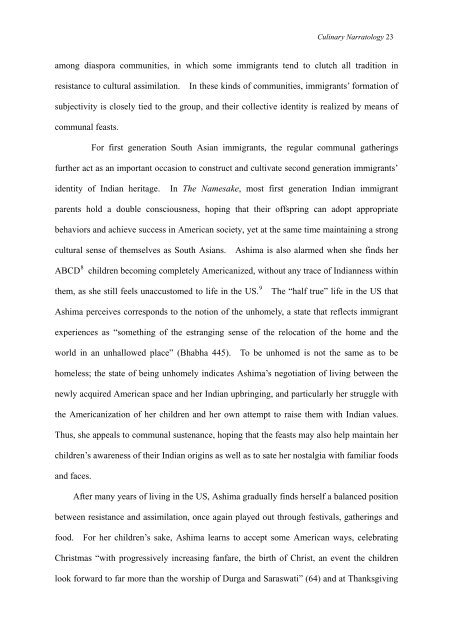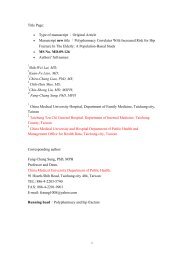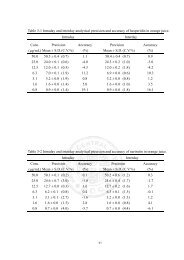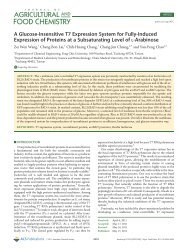Culinary Narratology in Everyday Life: Foodways and Identity ...
Culinary Narratology in Everyday Life: Foodways and Identity ...
Culinary Narratology in Everyday Life: Foodways and Identity ...
Create successful ePaper yourself
Turn your PDF publications into a flip-book with our unique Google optimized e-Paper software.
<strong>Cul<strong>in</strong>ary</strong> <strong>Narratology</strong> 23<br />
among diaspora communities, <strong>in</strong> which some immigrants tend to clutch all tradition <strong>in</strong><br />
resistance to cultural assimilation. In these k<strong>in</strong>ds of communities, immigrants’ formation of<br />
subjectivity is closely tied to the group, <strong>and</strong> their collective identity is realized by means of<br />
communal feasts.<br />
For first generation South Asian immigrants, the regular communal gather<strong>in</strong>gs<br />
further act as an important occasion to construct <strong>and</strong> cultivate second generation immigrants’<br />
identity of Indian heritage. In The Namesake, most first generation Indian immigrant<br />
parents hold a double consciousness, hop<strong>in</strong>g that their offspr<strong>in</strong>g can adopt appropriate<br />
behaviors <strong>and</strong> achieve success <strong>in</strong> American society, yet at the same time ma<strong>in</strong>ta<strong>in</strong><strong>in</strong>g a strong<br />
cultural sense of themselves as South Asians. Ashima is also alarmed when she f<strong>in</strong>ds her<br />
ABCD 8 children becom<strong>in</strong>g completely Americanized, without any trace of Indianness with<strong>in</strong><br />
them, as she still feels unaccustomed to life <strong>in</strong> the US. 9<br />
The “half true” life <strong>in</strong> the US that<br />
Ashima perceives corresponds to the notion of the unhomely, a state that reflects immigrant<br />
experiences as “someth<strong>in</strong>g of the estrang<strong>in</strong>g sense of the relocation of the home <strong>and</strong> the<br />
world <strong>in</strong> an unhallowed place” (Bhabha 445). To be unhomed is not the same as to be<br />
homeless; the state of be<strong>in</strong>g unhomely <strong>in</strong>dicates Ashima’s negotiation of liv<strong>in</strong>g between the<br />
newly acquired American space <strong>and</strong> her Indian upbr<strong>in</strong>g<strong>in</strong>g, <strong>and</strong> particularly her struggle with<br />
the Americanization of her children <strong>and</strong> her own attempt to raise them with Indian values.<br />
Thus, she appeals to communal sustenance, hop<strong>in</strong>g that the feasts may also help ma<strong>in</strong>ta<strong>in</strong> her<br />
children’s awareness of their Indian orig<strong>in</strong>s as well as to sate her nostalgia with familiar foods<br />
<strong>and</strong> faces.<br />
After many years of liv<strong>in</strong>g <strong>in</strong> the US, Ashima gradually f<strong>in</strong>ds herself a balanced position<br />
between resistance <strong>and</strong> assimilation, once aga<strong>in</strong> played out through festivals, gather<strong>in</strong>gs <strong>and</strong><br />
food. For her children’s sake, Ashima learns to accept some American ways, celebrat<strong>in</strong>g<br />
Christmas “with progressively <strong>in</strong>creas<strong>in</strong>g fanfare, the birth of Christ, an event the children<br />
look forward to far more than the worship of Durga <strong>and</strong> Saraswati” (64) <strong>and</strong> at Thanksgiv<strong>in</strong>g









